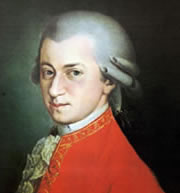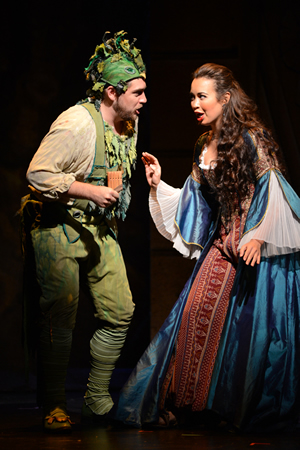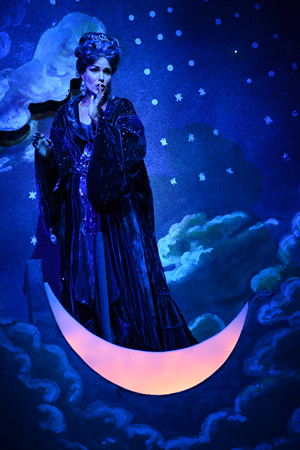Review
Virginia Opera's Magic Flute Delights,
Despite Obstacles
by Megan Beets
December 2013

Wolfgang A. Mozart
|
Conductor: Mark Russell Smith
Director: Michael Shell
Cast
Sarastro: Kenneth Kellogg
Tamino: Matthew Plenk
Pamina: Nadine Sierra
Queen of the Night: Heather Buck
Papageno: David Pershall
First Lady: Natalie Polito
Second Lady: Courtney Miller
Third Lady: Sarah Williams
Monostatos: Ryan Connelly
Papagena: Amanda Opuszynski
Speaker: Matthew Scollin
First Priest: David Blalock
Second Priest: Andre Chiang
Spirit 1: Anna Maples
Spirit 2: Fran Coleman
Spirit 3: Kristen Choi
First Armored Man: Ben Kwak
Second Armored Man: Matthew Scollin

Photo credit: David A. Beloff
|
By the time Mozart's final opera, The Magic Flute, took the stage in Vienna at the Freihaus-Theater auf der Wieden on September 30, 1791, the world stood in rapt attention, eyes riveted on the broader stage of world history, where the great promise of the replication of the American Revolution was threatening to dissolve into a sea of violence and chaos in the disaster which would come to be known as France's Jacobin Terror. It was in response to this that the great Poet of Freedom, Friedrich Schiller remarked that “a great moment has found a little people.” Mozart, who had made the decision to move to Vienna ten years earlier, and into direct collaboration with a tightly-knit circle of republicans, faced the possibility that all could be lost, and that the effort to give the victory of the American Revolution a firm grip upon European soil would not succeed.
Friedrich Schiller, in his 1794 Letters on the Aesthetical Education of Man, asserted that in order to transform a degenerate or debased population to one of dignity and reason, you cannot “assail their maxims” and “condemn their deeds,” but you must “try your fashioning hand on their idleness; drive away lawlessness, frivolity and brutality from their entertainment, [and] you will imperceptibly banish them from their actions, finally from their character.” Schiller instructs, “Where you find them, surround them with noble, great and ingenious forms, place the symbols of excellence all around them, until reality is overcome by appearance and nature is overcome by art.” [1] It was in this spirit that Mozart and his collaborators staged a great intervention.
1791, Mozart's last year, was a time of tremendous upheaval in Vienna, and for Europe at large. In February of 1790, Emperor Joseph II, a controversial ruler and, at times, direct collaborator of Mozart, died, to be replaced by his brother Leopold. Joseph, who had become the sole ruler of the Holy Roman Empire with the death of his mother, Maria Theresa, had taken a series of controversial measures to break the power of the feudal oligarchy. He freed the serfs, granted religious toleration to Protestants and Jews (and temporarily weakened the political control of the Church), provided measures for public education, commerce, public hospitals and public works. He also collaborated with Mozart, Emanuel Shikaneder and others on a German national theater project, even intervening with the censors to allow Mozart's 1782 German-language opera, The Abduction from the Seraglio, to go forward, despite its challenge to the “Christian” Viennese who were about to take the empire to war with the Turks.[2] While Joseph was still alive, the masonic lodges which were the gathering places of many of the republican leaders of Vienna (including lodges frequented by Mozart, which centered around the personality of the “Benjamin Franklin” of Vienna, Ignaz von Born) had some degree of protection from sabotage and shutdown by the head of the secret police, Count Pergen (who was immediately dismissed by Leopold upon his taking power).
Emperor Leopold II (for whose 1790 coronation celebration Mozart composed La Clemenza di Tito, exalting love and mercy over mere might and revenge) attempted to continue many of the reforms of his brother, but would survive barely two years. Upon his death, only a few months after that of Mozart, the Austro-Hungarian Empire would find itself once again marching off to war, under the eye of the reinstated head of the secret police, Count Pergen.
It was upon these this population, which would soon have to decide whether it would break the system of oligarchy and rise to the level of citizens of a republic, that Mozart and his friend and librettist Shikaneder “tried their fashioning hand,” in what would be their last collaboration. While full of light-hearted jokes and hilarious characters, such as the Shikaneder-created Papageno, the subject matter at the heart of The Magic Flute is one of the most crucial to be faced for any society. Centering on the crucial issue of aesthetical education, two young nobles, Tamino and Pamina, must face the challenge which must be faced by all in a republic: to yield the uneducated, baser impulses to the rule of the higher masters of reason and truth. The untamed emotions of rage, fear, and despair, and even of newly-sparked love, which the two express throughout the opera, are transformed within the Temple of Wisdom as the couple conquers the mortal trials through the love of beauty and truth.
An Outstanding Cast Pulls Through
Unfortunately, the director of the Virginia Opera's December 2013 production, Michael Shell, knew nothing (or didn't think he had to) of the opera's true history and intention, and introduced a “modern” viewpoint from which from which to stage the production which had nothing to do with Mozart's much higher aim.
The otherwise well-performed overture was marred by the pantomimed staging of the strange decision to situate the entire opera's plot within the dream of a quarreling couple, for the ostensible reason that the actual meaning of the opera was a story of “good versus bad...that has been played out on our televisions and in our lives, sometimes in our most intimate relationships: husband versus wife or partner versus partner.” Rather than taking on the difficult task of making Mozart transparent to the audience, getting “out of the way” so that his and Schikaneder's sublime composition could speak to us for itself, Shell apparently felt the (unnecessary) desire to “make it relevant” to a contemporary audience. (Situating The Magic Flute as a “plot within a plot” has, unfortunately, become increasingly popular on modern opera stages.)
Alongside this, Shell also chose to burden the scene with a scattering of anachronistic, random junk, such as the ridiculous and inexplicable hand-shaped chair sat in by one of the monks of the temple, the sunglasses worn by the temple initiates, and the disco ball behind the three ladies in the first act. These odd interruptions of the time and place of the drama, as if in attempt to jar the audience member out of being sufficiently subsumed in the world unfolding on stage, were, however, few enough that the mind of the audience member could quickly regain its place.

Photo credit: David A. Beloff
|
Fortunately for the audience, Shell's odd (though nowadays all-too-common) disregard of Mozart's intention couldn't overshadow the superb performance of the singers, who didn't seem to be phased by the occasional random element they were saddled with. Matthew Plenk played an excellent Tamino—one of the best this reviewer has heard. Not only was his tenor voice powerful and unblemished with the tightness that plagues many tenors heard on today's stages, but he captured the transformation that Tamino must undergo—from a head-strong, and easily manipulated young prince, to a creature of reason, worthy of the name of “man.” Nadine Sierra excellently portrayed the parallel struggle of Pamina, as she rises from the naivete of a sheltered princess to realize her true role alongside her prince.
The role of the Queen of the Night was marred, though certainly not by soprano Heather Buck, who conveyed both the commanding presence and weak desperation of the queen in the vocally demanding role, with clear, beautiful high notes; but again by Shell, who imposed an odd yin-and-yang view on the Queen. Rather than being banished as her daughter rises to the level of reason, rejecting her mother's thirst for vengeance, the Queen is brought into the temple as co-regent with Sarastro, a “resolution” of good and bad.
Despite the conceptual obstacles presented to the audience by this production, the strong cast pulled through, and was able to let the beautiful, sublime music of Mozart captivate. Perhaps in the future the Virginia Opera should not feel the need to experiment with “new productions,” and will let the beauty and uplifting message of Mozart and Schikaneder, so relevant to today's population, speak to us for itself.
Footnotes:
[1]. “On the Aesthetic Education of Man in a Series of Letters,” Friedrich von Schiller, 1794. Translated by Patricia Noble.
[2]. In a break from the original story line, in which the “heathen” Pasha only lets the Christian gentleman, Belmonte, go free when he discovers that Belmonte is really his long-lost son, Mozart chose a different, and more polemical ending. In it, the Pasha is revealed to have been deprived of both country and love by the father of Belmonte, and yet, in an act of Christian-like mercy, tells Belmonte, “I despised your father far too much ever to follow in his footsteps. Take your freedom, take Constanze, tell your father that you were in my power, that I released you so that you might tell him that it is a far greater pleasure to repay injustices suffered by good deeds than to compensate evil by more evil.”
